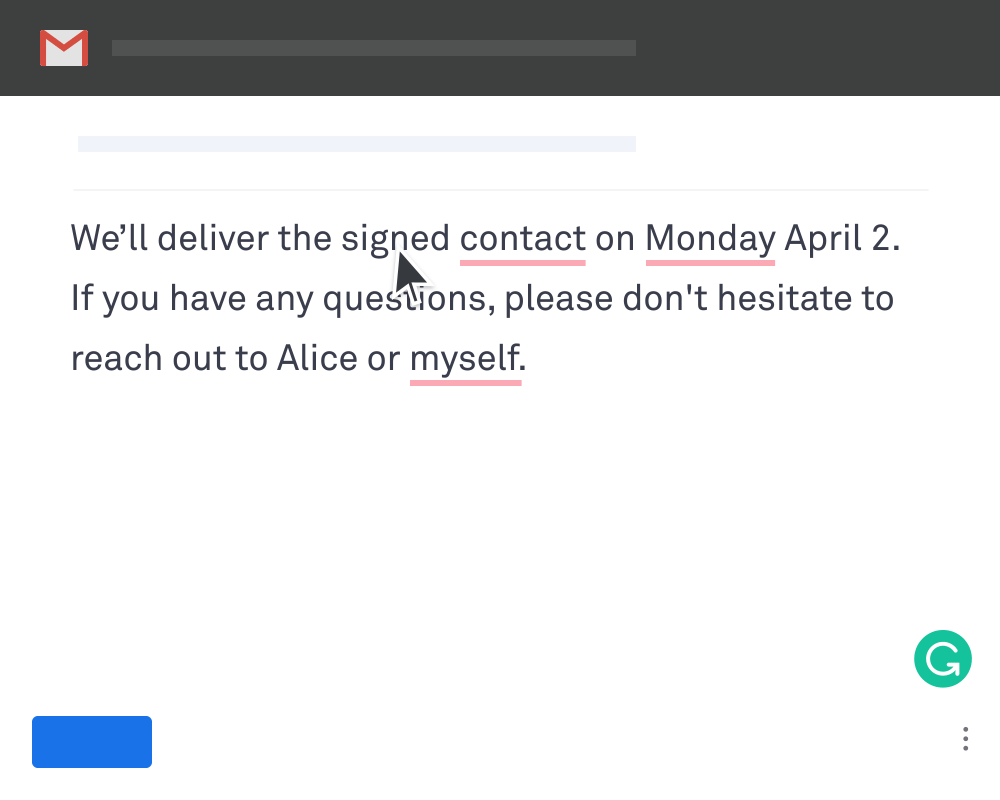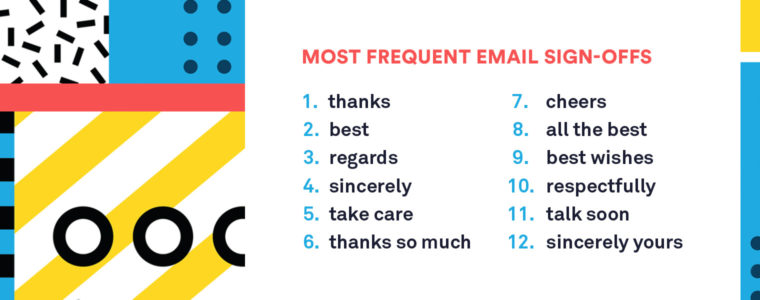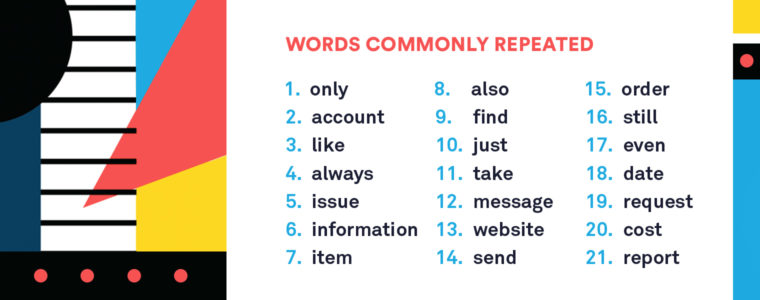How Do I Use Emils Art an Su Far
Whether you're an up-and-coming young professional or a seasoned manager, email writing is a vital aspect of concern communication. And thanks to what'south often seen as the mysteries of English grammar and the subtleties of the written word, it tin can be a daily struggle. That's especially truthful if you lot have to motivate busy people to reply or address a potentially touchy subject. To write a great electronic mail, you need to know 2 things: common mistakes to avoid, and next-level strategies to become alee.
But first things get-go—you have to know what a great email looks like if you're going to write i.
Here's a tip: Whether you're writing an electronic mail, creating a presentation, or just sending a quick tweet, Grammarly can help! Endeavor Grammarly's app to make your writing cleaner and more impressive.

Beefcake of a skilful email
Every e-mail you write has the same basic structure: Subject line, greeting, electronic mail body, and endmost. Only every bit with every written class of professional person advice, there's a right way to exercise it and standards that should be followed. Hither'south how to write a proper email:
1 Subject line
The subject field line could be the most important part of the e-mail, though it'southward often overlooked in favor of the email trunk. But if y'all're cold-emailing someone, or simply establishing a professional relationship, your subject line can entice people to open the message as well as set expectations well-nigh what's enclosed. On the other hand, a poorly crafted or generic subject line (similar "Hullo" or "You don't desire to miss thos") can deter the reader and result in your email landing in the spam folder.
"Spend double the corporeality of time crafting the right bailiwick line as you exercise on the [trunk] because if they don't open the email, information technology doesn't affair," says Cole Schafer, founder and copy chief of Honey Copy.
2 Openers
In nearly email writing situations, y'all'll want to include a quick greeting to acknowledge the reader before diving into your primary message or request.
The exception: When you're on an email concatenation with close colleagues, it frequently becomes more natural to drib the opener (as well as the closing). Though information technology may initially feel like a faux pas, it signals a better professional rapport.
3 Body
The torso of an email is the meat of your message, and it must take a clear and specific purpose, such every bit getting feedback on a presentation or arranging a coming together with a new customer. It should likewise exist concise. That way, people will be more than inclined to read information technology, rather than skimming information technology and risking missing critical data. If you can, eddy it downwards to a few choice sentences.
And for emails that require more length and item, keep it as focused as you lot can. "Nobody wants to receive a novel. You want to keep it between three, four, or five lines of text," says Schafer.
4 Closings
Just as y'all want to start things off on the right foot with your greeting, y'all also want to part well. That means writing a friendly sign-off. And there are enough of options to cull from.
For case, here are 12 common, and professional, closings that Grammarly users chose on a given day:

You'll want to choose a closing that feels 18-carat to your personality and tailor it to the human relationship to ensure an advisable level of professionalism. On the other manus, mutual closings similar "dear," "sent from iphone," or "thx," may be best left unused in professional emails.
You tin can add any give-and-take to your Personal Dictionary.
Which words will you add? #cleanwritinghttps://t.co/itTRLCarol
— Grammarly (@Grammarly) September xviii, 2018
Common email writing mistakes (and what to do instead)
Just as every email is an opportunity for professional growth, at that place'due south also the potential to fall into mutual email writing bad habits. Here are 8 mistakes to avoid:
1 Omitting necessary Oxford commas
The Oxford comma can be somewhat polarizing when thinking about how to write a proper electronic mail, depending on which style guide is utilized for professional communications in your industry —it'southward ordinarily either shunned or hailed every bit a tool for clarification. Either way, a lot of people have strong opinions about it. But leaving them out tin lead to confusion, depending on the sentence.
Just like a healthy marriage, AP style calls for clear communication. Nosotros besides believe in the value of compromise. Then as a reminder, the Stylebook doesn't prohibit all Oxford commas. If omitting a comma could atomic number 82 to confusion or misinterpretation, then utilize the comma. https://t.co/vGsuRrwpQW
— AP Stylebook (@APStylebook) Baronial 15, 2018
What to practice instead: While the Oxford comma may not be suitable in certain contexts, it's commonly a skilful idea to use them in emails. That's because it can assist you save time and avoid miscommunication, confusion, and fifty-fifty legal trouble.
ii Hedging
Grammarly users know that when information technology comes to hedging, it'due south better to omit information technology than leave it in, peculiarly in emails. And if you're worried almost coming off as boorish, don't be: Contrary to popular belief, hedging linguistic communication makes yous audio less confident, which can ultimately undermine your writing.
What to do instead: State your idea or opinion, then explain the "why" behind your reasoning. That way, you'll be better understood and your luminescence tin smooth through.
3 Extremely long and/or unclear copy
Would y'all read an email that was 1,000 words long? Probably not—most people skim emails that are on the long side. And if you add hard-to-follow sentences or mixed messages, to your draft, you're even less likely to get a satisfactory response. (Or any response.)
"I get a ton of [emails] that are just these huge blocks of text. And I understand why they practice that—and so y'all have enough particular. Merely it's actually difficult to read and I'm not going to read the whole thing," says Kat Boogaard, a Wisconsin-based freelance writer.
What to do instead: Keep it concise and focus on the matter at hand. Then stop with a telephone call to activeness, a requested response date, and make it clear that you're open to questions and follow-ups (if that's the example).
4 Existence as well casual (or formal)
Depending on your circumstances, wavering likewise much to the casual or formal side of writing can be a misstep. Being overly coincidental is often seen as a rookie mistake, but stiff, formal language can too exist detrimental to your message.
What to practise instead: In striking the perfect balance between formal and coincidental, the central is thinking almost the relationship between yourself and the recipient and take social cues as your communication progresses.
"You kind of want to see what someone else is doing and participate, play forth, sort of acknowledge the way communication develops and the way expectations in a relationship develop," says Dan Post Senning, an etiquette expert at the Emily Post Institute.
five Cliches
Non all email cliches are fundamental sins. Sure aspects of your emails are spring to be a little formulaic. Later all, most emails take the aforementioned basic structure, and in that location are phrases that you may utilise to ensure clarity or embrace your bases. But if you're going to repeat phrases, make certain they have a articulate purpose.
As Kiera Wright-Ruiz, a social media manager at Google's Local Guides puts it, "Even though I e'er repeat, 'delight permit me know if you accept any questions,' I actually do desire to know if they have questions."
Nonetheless, most of the fourth dimension, you'll desire to edit out cliches whenever possible since they can make people tune out. Here are the top seven to avert:

Method: We searched for terms used by Grammarly users based on our nigh popular web log manufactures.
What to do instead: Try reading the typhoon for cliches, tone, and phonation to more effectively communicate your message while keeping the reader engaged. Ask yourself: If your boss (or mom) read this email, would you be happy with information technology? If the answer is yep, then y'all're on the right track.
half-dozen Repetition
People oft echo words within the same paragraph, twice in two sentences, or only too shut together to go unnoticed. While it'southward not the worst offense, it'south another affair that can make a reader tune out.
Here are the most commonly repeated words to avoid:

What to practise instead: Try reading your draft out loud, using the text-to-speech part on your phone, or running information technology by a colleague before sending it off. Grammarly can also assist you catch these repeated or overused words.
vii Robotic language
E-mail may be a descendant of snail mail, but that doesn't mean your messages should audio similar an old-timey version of yourself. In fact, emails should sound like the person who is writing it. So using phrases that sound like something out of a Victorian novel isn't the best move if you want to connect with the reader.
"Permit's face information technology: Nobody wants to read a college textbook. You lot want to read a blog or an article or a existent chat. They're a person, they're not a robot. So employ language that sounds like something you would say if y'all're just sitting in a coffee shop," says copy primary Schafer.
What to do instead: You can go a more natural effect by pretending you're writing to a friend or having a conversation with a friendly acquaintance. For case, you probably wouldn't say something like, "Greetings" and "I hope the weather is off-white where you are" if you were meeting someone for java. Yous'd say something similar, "Hello" and "Thank you again for your time."
8 Overuse of assertion points!
Enthusiasm is great. But in sure contexts, the overuse of exclamation points can practice more harm than good. This is especially true if you're forging a new relationship or contacting someone outside of your company. You are, later on all, a representative of your work when you use a company email accost. Simply people honey assertion points, and they're nonetheless something that many people rely on to convey a positive tone.
For example, here are the about common sentences and words people employ with assertion points in emails:

What to do instead: After you lot've written your draft, practice a quick search for exclamation points and use your judgment to make up one's mind which (if whatever) to keep based on your human relationship with the recipient. As a general rule, try to keep it to ane or 2 per email with colleagues.
Nosotros're feeling grateful today.
Grateful that a content superstar like @MarketingProfs uses Grammarly. #fridayfeeling #ourherohttps://t.co/rrLpgheikv
— Grammarly (@Grammarly) September 28, 2018
Side by side-level email writing moves
Once you lot've got the proper email format and y'all know what mistakes to avoid, information technology's time to focus on making your drafts stand out from the myriad emails most people get every day. Here are four strategies to take yours to the next level:
Think positive
Sending an e-mail that is remotely negative, or even neutral, tin put you in a tricky place. And as with any written communication, there may exist room for misinterpretation.
"In the absence of other information, our interpretation often defaults to the negative," explains communication-etiquette expert Post Senning. "When you're talking about negative advice, you lot're [missing] the data that is tone of voice, the twinkle in your eye, the expert sense of humour that you intend something with or even the 18-carat care or concern with which y'all're offering critique. And so be really careful. When something reads equally negative to yous, information technology probably comes beyond as fifty-fifty more negative to someone else."
Strike the right tone
Yous wouldn't want to get an email that reads, "Dear [client]," or which references your work in public relations when you're actually in sales, because it would immediately testify that the sender is either mass emailing y'all, or they didn't do the proper research and find the right contact. Similarly, you'll want to make sure that every email you send has a tone that's crafted specifically for the recipient, and that you're sending it to the right person.
Then even though it may be tempting to use templates, it'southward important to personalize it and keep in mind the communication way of the recipient before hit send. To achieve this, a quick Google search or a peek at the recipient'due south LinkedIn or Twitter feed tin can do wonders.
Before sending, try putting yourself in the recipient's shoes for a gut-check on tone and content. And if you have a difficult time reading your own tone in electronic mail, Grammarly'south tone detector can help yous make up one's mind how y'all sound to your recipient.
Follow up—in skillful time
If you're sending an email, you're likely looking for a timely response. Only with the large amounts of emails most people sort through each day, things tin can end up getting lost. As a general rule, a follow-up message should never come less than xx-four hours after sending the initial electronic mail.
In other words: Don't exist the person who sends a follow-up request two hours later sending. In extreme cases, that kind of beliefs can even get you blocked. "When y'all're taking more time and actually caring about the person on the other side of the email, y'all're immediately going to see a much higher response rate. I had to learn that the hard fashion," says copy master Schafer.
Make it easy on the eyes
Well-nigh of the messages you ship will probable be on the shorter side, which is great for rapid responses and getting things done. Only for longer emails, scannability is the name of the game. That's when things like bolded font, bullet points, underlined sentences, and a TL;DR (too long, didn't read) section come in handy.
There are a lot of factors to proceed in mind when composing an email, and there'south a wide margin of mistake. Merely afterward all is said and done, it isn't near perfection. It's about effective communication.
"I think people feel this pressure that yous need to be this perfect communicator with this huge vocabulary and these perfectly structured sentences. And I don't know that that'southward always the case because you're simply two people, communicating," says freelance author Boogaard.
More from Grammarly:
- How Does Grammarly Piece of work?
- How Grammarly Helps You Learn
- See Grammarly's Tone Detector
![]()
Source: https://www.grammarly.com/blog/email-writing-tips/
0 Response to "How Do I Use Emils Art an Su Far"
Post a Comment